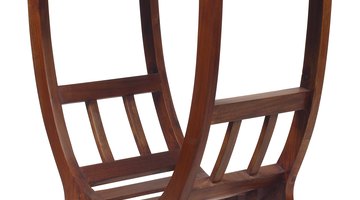Danish Oil Removal
Danish oil is a penetrating sealer, designed to bring out the grain and color of wood surfaces while also protecting them from moisture and damage. Unlike other finishes, polyurethane or water-based for example, Danish oil seeps down deep into the structure of the wood instead of just sitting on top of it.

While this is an excellent characteristic for protecting a surface, it makes Danish oil harder to remove than other finishes. Stripping it away requires a multiple step approach before the project is suitable for a new coating.
Things You Will Need
- Chemical stripper, liquid or paste
- Rags
- Putty knife
- Wood scraper
- Sandpaper or steel wool
- Painter's tape
Warning
Most, if not all, chemical strippers are toxic. Use gloves to avoid contact with the skin, and always provide adequate ventilation.
-
Use your painter's tape to isolate the area where you need to remove the Danish oil. The stripping chemicals can damage anything they come in contact with, so be certain to protect adjacent surfaces before you begin.
-
Apply the stripper as indicated by the manufacturer's label, following the directions precisely. Most call for leaving the stripper in place for a certain amount of time. Don't rush the job by skipping this step or you will end up working much harder than you need to.
-
Use your putty knife and rags to remove as much of the Danish oil as possible after the stripper dries. The majority of it should bubble up and slide right off. Clean away the stripper residue as directed by your product, and then wipe the surface clean.
-
Sand the surface with steel wool or sanding paper to remove any remaining oil or debris. If there is a great deal left, use 60 grit to remove the bulk of it, then switch to a finer grit like 80 or 120, depending on the type of wood and finish used for your project.
The Drip Cap
- Danish oil is a penetrating sealer, designed to bring out the grain and color of wood surfaces while also protecting them from moisture and damage.
- Use your putty knife and rags to remove as much of the Danish oil as possible after the stripper dries.
- If there is a great deal left, use 60 grit to remove the bulk of it, then switch to a finer grit like 80 or 120, depending on the type of wood and finish used for your project.
References
Writer Bio
Gregg Miller has been a professional educator, writer and language tutor since 1996 and contributes to various websites. He specializes in education, fitness and language articles. He has a Master of Education in teaching English as a second language from Grand Canyon University and a Bachelor of Arts in Asian studies from the University of Florida.
Photo Credits
- Hemera Technologies/PhotoObjects.net/Getty Images
- Hemera Technologies/PhotoObjects.net/Getty Images
More Articles



